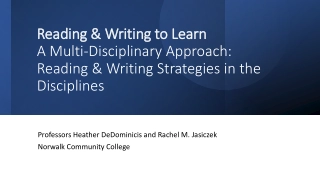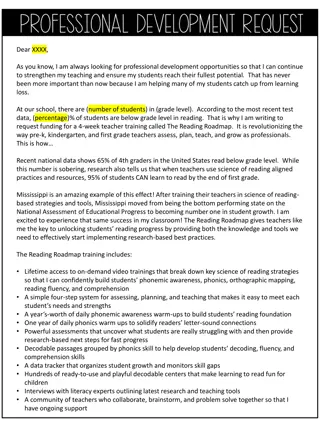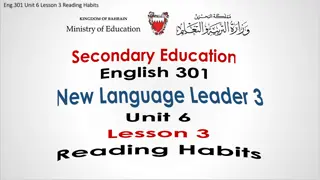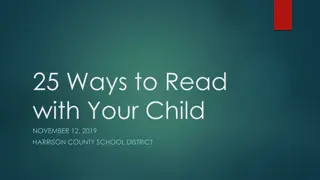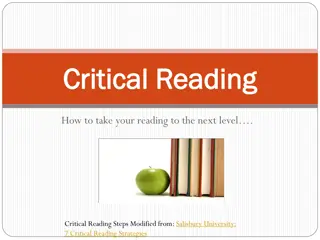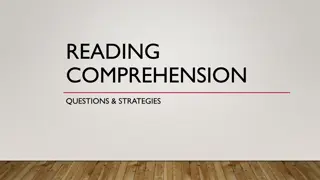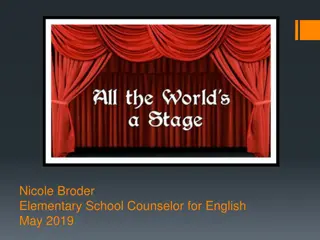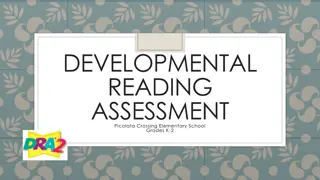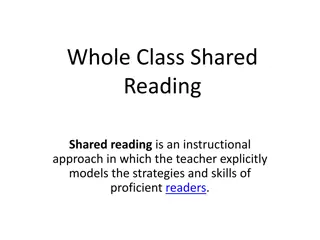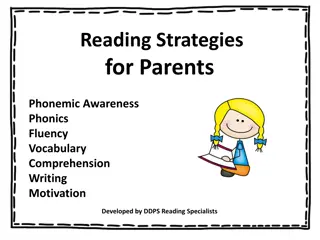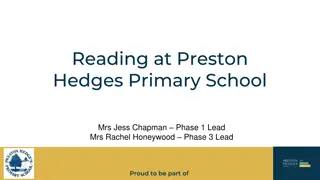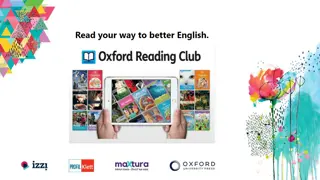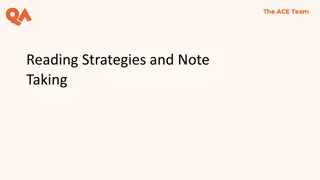Enhancing Reading Skills: Strategies and Benefits
Explore the world of reading through different purposes, genres, and strategies like skimming, scanning, and intensive reading. Develop essential reading skills, comprehend texts, and practice faster reading with good comprehension. Discover the joy of reading for pleasure, learning, and evaluating information from various sources. This course covers basic skills and encourages the development of reading habits.
Download Presentation

Please find below an Image/Link to download the presentation.
The content on the website is provided AS IS for your information and personal use only. It may not be sold, licensed, or shared on other websites without obtaining consent from the author.If you encounter any issues during the download, it is possible that the publisher has removed the file from their server.
You are allowed to download the files provided on this website for personal or commercial use, subject to the condition that they are used lawfully. All files are the property of their respective owners.
The content on the website is provided AS IS for your information and personal use only. It may not be sold, licensed, or shared on other websites without obtaining consent from the author.
E N D
Presentation Transcript
How long do you spend time for reading a day? Do you like reading? What What kind of books do you like most? motivates you to read?
READING IS....... The process of looking at a series of written symbols and getting meaning from them.
For pleasure To get the main idea of an information (read newspaper) To locate specific information (date, term) To learn the information (reading to learn) To synthesize informatiom from multiple text (evaluate information) To get general comprehension (reading to understand main idea and supporting information) Grabe, et al (2016)
Vs Popular Academic Non-fiction Research/education Sources cited Specialist outlets Specialist audience Theory Objective Non-commercial/private Fiction Leisure Informal No reference list Widely available Broad audience Entertainment Subjective Commercial
How do you read the following? Newspaper Novel Textbook Journal article
Reading Strategies Skimming Scanning Intensive Reading
This course covers some basic reading skills for reading texts e.g. guessing the meaning, findings topic and main ideas, finding purpose of a text, etc. Practices on using the skills will be explored in the exercises that follow the texts. This course also encourages students to develop their reading habits
Comprehend texts Apply reading comprehension skills Practice reading faster with good comprehension Develop reading habits
Materials Course overview 1 Guessing the meaning of new words 2 Finding main ideas 3 Understanding Pronoun 4 Understanding punctuation 5 Making notes 6 Recognizing word forms 7 Syllabus MID-TEST 8 Previewing Reading 9 Finding purpose 10 Using topic sentence to preview 11 12 Finding Details Previewing Reading & infinitives of Purpose 13 Using topic sentence to preview & finding details 14 Review all of material 15 16 FINAL TEST
Book Source: Hartmann, Pamela. 2007. Quest Intro: Reading & Writing. New York: McGraw Hill.
Attendance Classroom participation Quizzes Mid-test Final test : 10% : 10% : 20 % : 25% : 35%
1. Work in group of 6 8 2. Make a small circle 3. Read the given text 4. Draw four picture that can represent the text 5. Switch your picture with the other groups 6. Rewrite the story based on the picture 7. Act it out.... 8. Make sure every member in your group have a role 9. The group with a highest score wins
The Boy Who Cried Wolf Once upon a time there was a shepherd boy who looked after the sheep in the hills near his village. He thought his job was very boring. One day, while he was sitting under a tree, he had an idea. He decided to have some fun, so he went down to the village and shouted Wolf!Wolf! at the top of his voice. As soon as the villagers heard the boy, they stopped work and raced to the hills to help him. But when they got there, they saw nothing. They returned to their work. After they d gone, the shepherd boy smiled to himself. A few days later, the boy did same thing again. Her ran into the village and shouted Wolf! Wolf!. The villagers didn t know whether to believe him or not, but they were worried about their sheep, so they had to help him. They went back to the hills. Again there was no wolf. They were angry because the shepherd boy had lied again, but he just laughed. Then, the next day, just before the sun was setting, a wolf really did appear, and it began attacking the sheep. In terror, the boy raced down the hill to the village, shouting Wolf!Wolf! . Although the villagers heard his cries, they did nothing to help. This time they really didn t believe him. The shepherd boy climbed up the hill to look for the sheep, but the wolf had killed them all. He was so ashamed of himself that he sat down in the moonlight and cried.
Materials Course overview 1 Guessing the meaning of new words 2 Unit 1 Page 8 Finding main ideas Unit 1 page 10 3 Understanding tones Unit 2 page 32 4 Understanding pronoun Unit 3 page 68 5 Understanding punctuation Unit 3 page 69 6 Making notes Unit 3 page 90 7 Syllabus 8 MID-TEST Recognizing word forms Unit 4 page 97 9 Previewing Reading Unit 5 page 124 10 Finding purpose/recognizing key word Unit 6 page 149 11 Using topic sentence to preview Unit 6 page 150 12 Finding Details Previewing Reading & infinitives of Purpose Using topic sentence to preview & finding details FINAL TEST Unit 6 page 154 13 14 15 16


